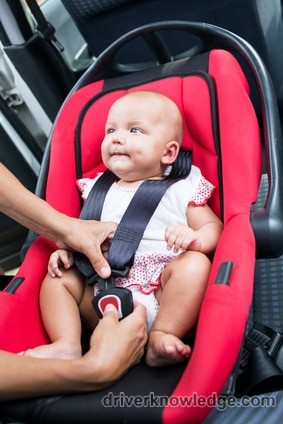Every parent wants to ensure their baby’s safety. Car seats are a vital part of transporting infants safely, but many are used incorrectly. Even a tiny mistake can be greatly magnified in the event of a car crash. Babies are fragile and while a car seat can help protect your little one, it’s important to make sure the seat really is secure. Avoid the following common mistakes.
- Don’t place the chest clip too low. The clip that goes across your child’s chest is extremely important. In a crash, this piece of plastic will restrain your baby and keep him in the seat. Unfortunately, the clip is often too low, which can allow the baby to fly out of the car seat on impact. To ensure the chest clip is positioned correctly, line it up with your child’s armpits.
- Don’t use a blanket or heavy jacket on your child. The straps on the car seat should be adjusted to fit your baby in regular clothing. If you wrap your infant in a blanket or put a heavy winter coat on your little one before strapping her in, you will need to adjust the straps. In a high impact situation, that soft coat will compact, making the straps too loose to keep your child safe. Avoid this problem by buckling your child in without the extras and then place a blanket over her. You can purchase special car seat blankets that will not slide off.
-
 Don’t leave the straps too loose. It can be tempting to leave the shoulder straps a little loose for easier maneuvering of your baby, but this can be very dangerous. Loose straps cannot hold an infant in the seat and the force in an accident will be much greater. If you can pinch the strap at your little one’s shoulder and get some excess, the strap is too loose. Tighten it up and try again.
Don’t leave the straps too loose. It can be tempting to leave the shoulder straps a little loose for easier maneuvering of your baby, but this can be very dangerous. Loose straps cannot hold an infant in the seat and the force in an accident will be much greater. If you can pinch the strap at your little one’s shoulder and get some excess, the strap is too loose. Tighten it up and try again.
- Don’t use the wrong strap position. There are usually multiple slots for the harness straps in a car seat. These should be used according to the size of your child and the position of the seat. If the seat is rear-facing, the straps should come from under the child’s shoulder and go up and over his shoulders. This prevents a small child from sliding up in the seat if there is an accident. In the front-facing position, the straps should come out of the seat above the child’s shoulders to hold him tightly to the seat in a crash.
- Don’t switch to front-facing too soon. While many areas still allow any child over one to face forward, this puts your baby in a dangerous position. Toddlers are still vulnerable and will suffer far more damage in a forward position if there is an accident. Protect your little one by keeping her in a rear-facing seat for as long as possible, depending on the weight and height restrictions of the seat.
- Don’t use both seat belt and LATCH at the same time. At first glance, it seems like using both the seat belt and the LATCH system would be the best way to keep your baby safe. However, car seats are only designed to use one or the other and using both systems can cause the seat to malfunction in the event of a crash. Pick one method of securing the seat and use it. Keep in mind that the LATCH system is rarely recommended for the middle seat.
- Don’t add toys and padding to the seat. Adding unauthorized items to the car seat can affect its function and should not be done unless the items are approved by the car seat manufacturer. While it may seem like a simple change, nothing is worth risking your baby’s life.
Keeping your child safe in the car requires proper car seat installation and use. If you aren’t sure how to install the car seat yourself, take the time to check the manufacturer’s instructions. Hospital staff may be able to help, as well. Always make sure your seat is being used properly to give your baby the safest ride possible.

 Don’t leave the straps too loose. It can be tempting to leave the shoulder straps a little loose for easier maneuvering of your baby, but this can be very dangerous. Loose straps cannot hold an infant in the seat and the force in an accident will be much greater. If you can pinch the strap at your little one’s shoulder and get some excess, the strap is too loose. Tighten it up and try again.
Don’t leave the straps too loose. It can be tempting to leave the shoulder straps a little loose for easier maneuvering of your baby, but this can be very dangerous. Loose straps cannot hold an infant in the seat and the force in an accident will be much greater. If you can pinch the strap at your little one’s shoulder and get some excess, the strap is too loose. Tighten it up and try again.